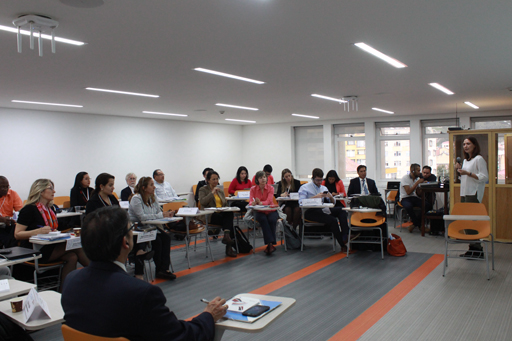Use 'Print preview' to check the number of pages and printer settings.
Print functionality varies between browsers.
Printable page generated Friday, 21 November 2025, 6:13 AM
Unit 2: Varied and active engagement
Unit 2: Varied and active engagement
Welcome to unit 2 which explores varied and active engagement. For learners to gain a deep understanding of new knowledge, skills, or values, they must actively engage with it.
Watch this video where James Lang explains this learning principle further.

Transcript
2.1 Active engagement
Active engagement can come through listening to a lecturer or viewing a video, but that should never be the only form of engagement that students have with the learning material. They should also have opportunities to engage with it in other ways, such as through writing, discussions, brainstorming activities, role plays, debates, group work, and peer-to-peer learning and assessment.
In all the E4J Modules, there are recommendations for teaching and learning activities that require students to actively confront ethical questions, problems, and challenges. Whether you choose to use these recommended activities or develop activities of your own, you should ensure that students are required not only to listen, read, or view (which are more passive forms of learning), but also to speak, write, act, and collaborate.
Activity 2.1 Active engagement 
2.2 Learning styles
You might have heard or read about the theory that students have different learning styles - such as visual learning, or auditory learning, and so forth - and that hence teachers should seek to identify the preferred learning style of every student and tailor instruction to it.
This theory has been used to support and promote a range of educational initiatives, some of them expensive and time-consuming to put into practice. Over the past two decades researchers have tested this theory that students have different learning styles in several different ways and found that it is not well-supported by the evidence (Brown, 2014).
While it is generally true that some of us prefer to read or listen to lectures while others like to engage in discussions or write, no evidence supports the idea that we learn more effectively or deeply when we are working in our preferred learning style.
Indeed, some researchers have discovered that students are often mistaken when they predict the type of activity that produces the greatest learning for them.
Desirable difficulties
We are discovering more and more that learning is most effective when it requires some effort on the part of the student, which means that students might learn more effectively when they are required to engage in activities that they find challenging.
The student who enjoys listening to lectures may learn comfortably from lectures, but when that student has to gather her thoughts and deliver them to her peers in a role play activity, that challenge to her comfortable style of learning may be more memorable to her than the most brilliant lecture she has attended.
The literature often refers to this phenomenon as “desirable difficulties’’ (Yue, Bjork and Bjork, 2013).
Activity 2.2 Personal values 
Watch the video What Are Your Values on the MindTools website and then scroll down below the video to Step 4.
Students are asked to think about the values and morals that they live by and list their top ten personal ethical rules. You can screen the video and then allow time in class for your students to develop their list. If time allows, they can also read the article and have a discussion in small groups.
What is the benefit of an activity like this?
Answer
It offers students a varied range of active forms of engagement with the learning material. We are discovering more and more that learning is most effective when it requires some effort on the part of the student, which means that students might learn more effectively when they are required to engage in activities that they find challenging.
2.3 Varied engagement
All of this leads to an important conclusion about the kinds of engagement activities that should be designed for students: they should be varied. If the lecturer does nothing but lecture to students, those students who do not respond very well to lectures - because they have difficulty paying attention for long periods of time, for example - are at a disadvantage.
Likewise, if the lecturer does nothing but have students engage in debates, those students who like to have the opportunity to read or listen quietly to an expert are at a disadvantage. As you are putting together plans to teach any of the Modules, you should consider how to offer varied methods for students to engage actively with the learning material.
One example of how to do this is given below.
Activity 2.3 How to uncover community corruption 
This exercise is from E4J Anti-Corruption Module 6. It includes the following components (the time allocation is a guideline only and you can adapt it according to the circumstances):
- Initial information provided to students via presentation and handout, accomplished by video and reading materials (10 minutes)
- Small groups discuss and come up with recommendations (15 minutes)
- Presentations by small groups on recommendations (15 minutes)
- Students vote on best recommendation (5 minutes)
- Debrief by facilitator (5 minutes)
You start this session with the following video and news article to set the scene:
Watch this clip which provides an example of how an artificial intelligence software (AI) could be used to detect corrupt activities within the civil service. The video also discusses the various ways of how such information could be used.
Read this article exploring nine ways to use technology to reduce corruption.
Afterwards, students are presented with the various means of reporting, including self-reporting and citizen reporting as well as the role of the new technologies to facilitate reporting of corruption, based on the relevant parts of the Key issues section of Module 6.
The general flow of the session is as follows:
- The groups should come up with suggestions for new ways to use technologies to combat corruption in their community.
- You should capture the feedback from the groups, for example on a flipchart or by using online poll tools such as Mentimeter or Slido. This will also facilitate the voting at the end of the exercise.
- You wrap up the session with additional examples of new technologies used for anti-corruption purposes. You may wish to show similar videos and articles from local media that might be more relevant and interesting to the students. Then, the students can vote on the best suggestion from the groups.
What challenges do you envisage in delivering this exercise and how could you overcome them?
Answer
Depending on the time available, you could decide to make the video compulsory preparatory work. Use the first part of the class to give clear instructions, and – whenever small groups are engaged in discussion – move from group to group to answer any questions they might have.
2.4 Class structures
As you use the Modules within your teaching, consideration should be given to the teaching sequence and timings to deliver the learning outcomes of a Module. Below is an example of a class structure used in E4J Ethics Module 13 on Public Integrity:
Example class structure
Discussion of ethical dilemmas is perhaps best achieved in small groups. The suggested length of this activity is 45 minutes, but you can adjust the timings to suit your requirements. You break students into small groups: for the first five minutes each student works individually by writing down an example of an ethical dilemma that he / she has faced in their own personal environment.
For the next 20 minutes the students get the opportunity to share their dilemmas in the small group - this is not compulsory and not everyone has to share. Students are requested to respect privacy issues and to acknowledge the stress that might be involved when sharing something very personal.
The final 20 minutes are spent on feedback from the groups: again - on an entirely voluntary basis - groups are invited to share one example with the class as a whole. You use the board or a flip-chart to capture keywords from the example, you lead a discussion and wrap up with your own views on the examples that have been shared.
Here is another example of a possible class structure for E4J Anti-Corruption Module 3: Corruption and Comparative Politics.
2.5 Conclusion

In this unit we have discussed the importance of active and varied engagement. To illustrate the application of this theory we have explored three exercises which illustrate how this can be achieved.
Go to Unit 3: The challenge of transfer now.

